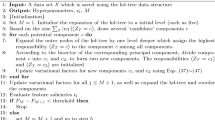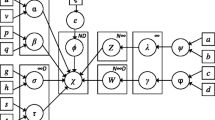Abstract
Learning appropriate statistical models is a fundamental data analysis task which has been the topic of continuing interest. Recently, finite Dirichlet mixture models have proved to be an effective and flexible model learning technique in several machine learning and data mining applications. In this article, the problem of learning and selecting finite Dirichlet mixture models is addressed using an expectation propagation (EP) inference framework. Within the proposed EP learning method, for finite mixture models, all the involved parameters and the model complexity (i.e. the number of mixture components), can be evaluated simultaneously in a single optimization framework. Extensive simulations using synthetic data along with two challenging real-world applications involving automatic image annotation and human action videos categorization demonstrate that our approach is able to achieve better results than comparable techniques.












Similar content being viewed by others
Notes
The complete source code of this work is available upon request.
Source code of PCA-SIFT: http://www.cs.cmu.edu/~yke/pcasift.
WordNet is a large lexical database for English, which groups English words into sets of cognitive synonyms called synsets.
Datasets are available at: http://vision.eecs.ucf.edu/datasetsActions.html.
References
Blank M, Gorelick L, Shechtman E, Irani M, Basri R (2005) Actions as Space-Time Shapes. In: Proc. of the IEEE International Conference on Computer Vision (ICCV), pp 1395–1402.
Bouguila N, Ziou D (2005) Using unsupervised learning of a finite dirichlet mixture model to improve pattern recognition applications. Pattern Recognit Lett 26(12):1916–1925
Bouguila N, Ziou D (2006a) Online clustering via finite mixtures of dirichlet and minimum message length. Eng Appl Artif Intell 19(4):371–379
Bouguila N, Ziou D (2006b) Unsupervised selection of a finite dirichlet mixture model: an MML-based approach. IEEE Trans Knowl Data Eng 18(8):993–1009
Bouguila N, Ziou D, Vaillancourt J (2004) Unsupervised learning of a finite mixture model based on the dirichlet distribution and its application. IEEE Trans Image Process 13(11):1533–1543
Chang E (2003) CBSA: content-based soft annotation for multinomial image retrieval using bayes point machines. IEEE Trans Circuit Syst Video Technol 13(1):26–38
Chang S, Dasgupta N, Carin L (2005) A Bayesian approach to unsupervised feature selection and density estimation using expectation propagation. In: Proceedings of IEEE conference on computer vision and pattern recognition (CVPR), pp 1043–1050
Datta R, Ge W, Li J, Wang JZ (2006) Toward bridging the annotation-retrieval gap in image search by a generative modeling approach. In: Proceedings of the 14th annual ACM international conference on multimedia (MM), ACM, pp 977–986
Dollár P, Rabaud V, Cottrell G, Belongie S (2005) Behavior recognition via sparse spatio-temporal feature. In: Proceedings of the IEEE international workshop on visual surveillance and performance evaluation of tracking and surveillance (VS-PETS), pp 65–72
Fan J, Gao Y, Luo H, Xu G (2005) Statistical modeling and conceptualization of natural images. Pattern Recognit 38:865–885
Figueiredo M, Jain A (2002) Unsupervised learning of finite mixture models. IEEE Trans Pattern Anal Mach Intell 24(3):381–396
Heskes T, Zoeter O (2002) Expectation propagation for approximate inference in dynamic Bayesian networks. In: Proceedings of the conference on uncertainty in artificial intelligence (UAI), pp 216–223
Hofmann T (2001) Unsupervised learning by probabilistic latent semantic analysis. Mach Learn 42(1/2):177–196
Ke Y, Sukthankar R (2004) PCA-SIFT: a more distinctive representation for local image descriptors. In: Proceedings of the IEEE conference on computer vision and pattern recognition (CVPR), pp 506–513
Laptev I (2005) On space-time interest points. Int J Comput Vis 64(2/3):107–123
Laptev I, Marszalek M, Schmid C, Rozenfeld B (2008) Learning realistic human actions from movies. In: Proceedings of the IEEE conference on computer vision and pattern recognition (CVPR), pp 1–8
Law MHC, Figueiredo MAT, Jain AK (2004) Simultaneous feature selection and clustering using mixture models. IEEE Trans Pattern Anal Mach Intell 26(9):1154–1166
Leacock C, Chodorow M (1998) In: Fellbaum C (Ed) WordNet: an electronic lexical database. MIT Press, pp 305–332
Liu J, Luo J, Shah M (2009) Recognizing realistic actions from videos “In The Wild”. In: Proceedings of IEEE conference on computer vision and pattern recognition (CVPR), pp 1996–2003
Luo J, Savakis AE, Singhal A (2005) A Bayesian network-based framework for semantic image understanding. Pattern Recognit 38:919–934
Ma Z, Leijon A (2010) Expectation propagation for estimating the parameters of the beta distribution. In: Proceedings of IEEE international conference on acoustics speech and signal processing (ICASSP), pp 2082–2085
Maybeck PS (1982) Stochastic models, estimation and control. Academic Press
McLachlan G, Peel D (2000) Finite mixture models. Wiley, New York
Mikolajczyk K, Schmid C (2004) Scale and affine invariant interest point detectors. Int J Comput Vis 60:63–86
Miller GA (1995) WordNet: a lexical database for English. Commun ACM 38:39–41
Minka T (2001) Expectation propagation for approximate Bayesian inference. In: Proceedings of the conference on uncertainty in artificial intelligence (UAI), pp 362–369
Minka T, Lafferty J (2002) Expectation-propagation for the generative aspect model. In: Proceedings of the conference on uncertainty in artificial intelligence (UAI), pp 352–359
Naphade MR, Huang TS (2001) A probabilistic framework for semantic video indexing, filtering, and retrieval. IEEE Trans Multimed 3:141–151
Rodriguez M, Ahmed J, Shah M (2008) Action mach a spatio-temporal maximum average correlation height filter for action recognition. In: Proceedings of IEEE conference on computer vision and pattern recognition (CVPR), pp 1–8
Russell B, Torralba A, Murphy K, Freeman W (2008) LabelMe: a database and Web-based tool for image annotation. Int J Comput Vis 77:157–173
Schüldt C, Laptev I, Caputo B (2004) Recognizing human actions: a local SVM approach. In: Proceedings of the 17th international conference on pattern recognition (ICPR), pp 32–36
Zhao R, Grosky WI (2000) From features to semantics: some preliminary results. In: Proceedings of the IEEE international conference on multimedia and expo (ICME). IEEE Computer Society, pp 679–682
Zhong D, Zhang H, Chang SF (1997) Clustering methods for video browsing and annotation. In: Proceedings of the SPIE conference on storage and retrieval for video and image databases, pp 239–246
Acknowledgments
The completion of this research was made possible thanks to the Natural Sciences and Engineering Research Council of Canada (NSERC). The authors would like to thank the anonymous referees and the associate editor for their comments. The complete source code of this work is available upon request.
Author information
Authors and Affiliations
Corresponding author
Rights and permissions
About this article
Cite this article
Fan, W., Bouguila, N. Non-Gaussian Data Clustering via Expectation Propagation Learning of Finite Dirichlet Mixture Models and Applications. Neural Process Lett 39, 115–135 (2014). https://doi.org/10.1007/s11063-013-9293-x
Published:
Issue Date:
DOI: https://doi.org/10.1007/s11063-013-9293-x




